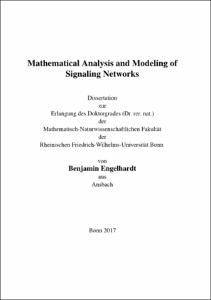Engelhardt, Benjamin: Mathematical Analysis and Modeling of Signaling Networks. - Bonn, 2017. - Dissertation, Rheinische Friedrich-Wilhelms-Universität Bonn.
Online-Ausgabe in bonndoc: https://nbn-resolving.org/urn:nbn:de:hbz:5n-49092
Online-Ausgabe in bonndoc: https://nbn-resolving.org/urn:nbn:de:hbz:5n-49092
@phdthesis{handle:20.500.11811/7303,
urn: https://nbn-resolving.org/urn:nbn:de:hbz:5n-49092,
author = {{Benjamin Engelhardt}},
title = {Mathematical Analysis and Modeling of Signaling Networks},
school = {Rheinische Friedrich-Wilhelms-Universität Bonn},
year = 2017,
month = nov,
note = {Mathematical models are in focus of modern systems biology and increasingly important to understand and manipulate complex biological systems. At the same time, new and improved techniques in metabolomics and proteomics enhance the ability to measure cellular states and molecular concentrations. In consequence, this leads to important biological insights and novel potential drug targets. Model development in systems biology can be described as an iterative process of model refinement to match the observed properties. The resulting research cycle is based on a well-defined initial model and requires careful model revision in each step.
{As an initial step, a stoichiometry-based mathematical model of the muscarinic acetylcholine receptor subtype 2 (M2 receptor)-induced signaling in Chinese hamster ovary (CHO) cells was derived. To validate the obtained initial model based on spatially accessible, not neces-sarily time-resolved data, the novel constrained flux sampling (CFS) is proposed in this work. The thus verified static model was then translated into a dynamical system based on ordinary differential equations (ODEs) by incorporating time-dependent experimental data.
To learn from the errors of systems biological models, the dynamic elastic-net (DEN), a novel approach based on optimal control theory, is proposed in this thesis. Next, the Bayesian dy-namic elastic-net (BDEN), a systematic, fully algorithmic method based on the Markov chain Monte Carlo method was derived, which allows to detect hidden influences as well as missed reactions in ODE-based models. The BDEN allows for further validation of the developed M2 receptor-induced signaling pathway and thus provides evidence for the completeness of the obtained dynamical system.
This thesis introduces the first comprehensive model of the M2 receptor-induced signaling in CHO cells. Furthermore, this work presents several novel algorithms to validate and correct static and dynamic models of biological systems in a semi-automatic manner. These novel algorithms are expected to simplify the development of further mathematical models in systems biology.},
url = {https://hdl.handle.net/20.500.11811/7303}
}
urn: https://nbn-resolving.org/urn:nbn:de:hbz:5n-49092,
author = {{Benjamin Engelhardt}},
title = {Mathematical Analysis and Modeling of Signaling Networks},
school = {Rheinische Friedrich-Wilhelms-Universität Bonn},
year = 2017,
month = nov,
note = {Mathematical models are in focus of modern systems biology and increasingly important to understand and manipulate complex biological systems. At the same time, new and improved techniques in metabolomics and proteomics enhance the ability to measure cellular states and molecular concentrations. In consequence, this leads to important biological insights and novel potential drug targets. Model development in systems biology can be described as an iterative process of model refinement to match the observed properties. The resulting research cycle is based on a well-defined initial model and requires careful model revision in each step.
{As an initial step, a stoichiometry-based mathematical model of the muscarinic acetylcholine receptor subtype 2 (M2 receptor)-induced signaling in Chinese hamster ovary (CHO) cells was derived. To validate the obtained initial model based on spatially accessible, not neces-sarily time-resolved data, the novel constrained flux sampling (CFS) is proposed in this work. The thus verified static model was then translated into a dynamical system based on ordinary differential equations (ODEs) by incorporating time-dependent experimental data.
To learn from the errors of systems biological models, the dynamic elastic-net (DEN), a novel approach based on optimal control theory, is proposed in this thesis. Next, the Bayesian dy-namic elastic-net (BDEN), a systematic, fully algorithmic method based on the Markov chain Monte Carlo method was derived, which allows to detect hidden influences as well as missed reactions in ODE-based models. The BDEN allows for further validation of the developed M2 receptor-induced signaling pathway and thus provides evidence for the completeness of the obtained dynamical system.
This thesis introduces the first comprehensive model of the M2 receptor-induced signaling in CHO cells. Furthermore, this work presents several novel algorithms to validate and correct static and dynamic models of biological systems in a semi-automatic manner. These novel algorithms are expected to simplify the development of further mathematical models in systems biology.},
url = {https://hdl.handle.net/20.500.11811/7303}
}






